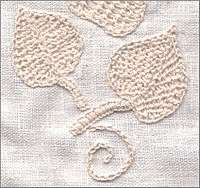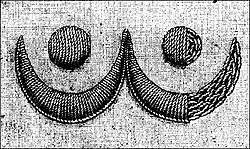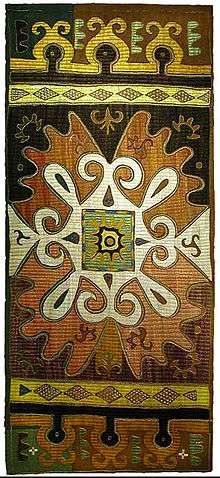Buttonhole stitch



Buttonhole stitch and the related blanket stitch are hand-sewing stitches used in tailoring, embroidery, and needle lace-making.
Buttonhole stitches catch a loop of the thread on the surface of the fabric and needle is returned to the back of the fabric at a right angle to the original start of the thread. The finished stitch in some ways resembles a letter "L" depending on the spacing of the stitches. For buttonholes the stitches are tightly packed together and for blanket edges they are more spaced out. The properties of this stitch make it ideal for preventing raveling of woven fabric.
Buttonhole stitches are structurally similar to featherstitches.
Applications
In addition to reinforcing buttonholes and preventing cut fabric from raveling, buttonhole stitches are used to make stems in crewel embroidery, to make sewn eyelets, to attach applique to ground fabric, and as couching stitches. Buttonhole stitch scallops, usually raised or padded by rows of straight or chain stitches, were a popular edging in the 19th century.
Buttonhole stitches are also used in cutwork, including Broderie Anglaise, and form the basis for many forms of needlelace.
Variants
Examples of buttonhole or blanket stitches include:
- Blanket stitch
- Buttonhole stitch
- Closed buttonhole stitch, in which the tops of the stitch touch to form triangles
- Crossed buttonhole stitch, in which the tops of the stitch cross
- Detached buttonhole stitch, in which rows of buttonhole stitches are worked to form a "floating" filling stitch
- Buttonhole shading, in which rows of buttonhole stitch are sewn in related colors to give a naturalistic shaded effect
- Buttonhole stitches combined with knots include:
- Top knotted buttonhole stitch
- German knotted buttonhole stitch
- Tailor's buttonhole stitch
- Armenian edging stitch
Buttonhole bars are parallel rows of thread laid across an open space in lace or cutwork and then completely covered with closely space buttonhole stitches.
Stitch gallery
 Detached buttonhole stitch
Detached buttonhole stitch Tailor's buttonhole stitch
Tailor's buttonhole stitch Buttonhole stitch variations
Buttonhole stitch variations Buttonhole shading
Buttonhole shading
See also
Notes
- ↑ Beeton, Isabella, Beeton's Book of Needlework, London, 1870
References
- Virginia Churchill Bath, Needlework in America, Viking Press, 1979 ISBN 0-670-50575-7
- S.F.A. Caulfield and B.C. Saward, The Dictionary of Needlework, 1885.
- Mrs. Archibald Christie. Samplers and Stitches, a handbook of the embroiderer's art, London 1920, 1989 facsimile: Batsford, ISBN 0-7134-4796-6.
External links
-
 Media related to Embroidery stitches at Wikimedia Commons
Media related to Embroidery stitches at Wikimedia Commons


